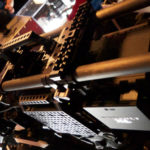
At a climactic moment in a rock video, the camera moves in on the guitar strings, bringing us closer and closer to the fingers of the player, then impossibly close, then we slip past the strings and enter the hole in the guitar. In a TV series about Las Vegas, the camera looks up from deep in the well of a craps table as the dice come tumbling by us, very close, and very large. In a gangster movie, the camera sits on the velvet surface of a pool table and we look up at the rack of balls, just as the cue ball comes crashing in.
In a road chase, we speed along, the camera crazily close to the ground, then pass unscathed under three vehicles. In another scene in a bowling alley, we are the bowling ball, hurtling down the lane toward our inevitable collision with the pins.
For the upcoming season of Austin City Limits, during a spirited performance, one of the cameras pointed at the stage rolls 115 feet along the wall of the balcony, without disturbing the audience’s sight lines, and with no hanging cables.
All these amazing shots have been made possible by devices pioneered or marketed by Innovision Optics in Santa Monica, California.

Founder Mark Centkowski built his first innovative imaging device when a client requested a specialized shot on a film he was producing.
“It was an endoscope, similar to what a proctologist would use,” he says. “But theirs were more waterproof, and mine had to fit a 16mm camera.”
That led to the founding of Innovision in 1989, and the eventual development of their signature products, the Probe lenses. These clever optics combine small size and long barrels with interchangeable Direct View, 45-degree, and 90-degree attachments, so the lenses can provide unique angles of view in many places where a conventional camera body would not fit.
Centkowski’s original Model 6000 endoscope series fit film cameras and had a T-stop of T28 (not 2.8) in 16mm and T45 in 35mm. Over the years since then, Innovision has improved the quality and light transmission of their products, through the Probe I, Probe II, and Probe II+ series. The current HD Probes have an effective aperture of T3.3 and lenses of 5mm, 8mm, 12mm, 17mm, and 23mm, and adapt to fit on any camera. Centkowski is working on a new set with 5K resolution.
At NAB last month, besides the Probes, Innovision was showing these new products, available for sale or rental:


- Rolly remote controlled, programmable, wall-crawling camera dolly (currently being installed in the Moody Theatre in Austin), in partnership with Movie Engineering of Milan, Italy, where it’s known as the Wally. The Rolly works on a dual track mounted horizontally on the wall. The track can follow the shape of the wall and even make turns. A cable channel tray preventsthe wiring from hanging down below the rig. A camera operator controls Rolly with a console, foot pedal, and a PC running special software. Payload: 25 lbs.


- Radcam radio-controlled, miniature camera car, now set up for DSLRs (for shooting low to the ground and under vehicles). Radcam accepts a variety of cameras of all sizes and can speed up to 20 mph and turn in a 60-degree radius, on all kinds of terrain. Joystick controlled. Lens height can be as low as 4″ off the ground. Camera load: 35 lbs, wireless focus available.

- Spintec rain deflector uses a Tiffen glass filter spinning at 3000 rpm to keep the front of your lens clear. A centrifugal effect instantly removes rain drops and splashes, and a vacuum effect can spin off snowflakes. Mounts on lenses with external diameters 75-105mm and uses a 12-volt power supply off the camera battery.

- Kamtrax vertical/horizontal sliders, available in two sizes, allow 36″ or 72″ of camera travel in either orientation. The rigs themselves are 44″ or 82″ long and can each carry a load of 30 lbs. Kamtrax can be mounted to a tripod for horizontal use or stand vertically with its support brackets. Or it can be locked at any angle for a Dutch tilt. Once the payload is balanced with small barbell weights, an operator can move the rig with fingertip control, and the camera will stay in any position without locking.

- Tombo dolly, also from Movie Engineering, features a programmable floor rail system controlled through a console, with pan-bar, pedals, and handwheels. The system uses customized tracks, either straight or curved in any radius from 3 to 20 meters. Cables stay out of the way, collected by a special cable chain. Tombo is known as Bullet Lift 2 Axes on the Movie Engineering website. Payload: 55 lb.






Thanks, Bill. I’ve often wondered how effects were achieved. But still: How can I BE the bowling ball? And how can even a fancy probe slip past the guitar strings to enter the hole in the guitar? I would like to see a clip of how those parts of the movies were made…
Hi Laurie: The Probe lenses get the camera’s perspective down close to the ground, or the bowling lane, closer than it could with a conventional lens. It’s still necessary to use a rolling camera dolly to move the camera down the lane toward the pins. So the Probes let you BE the ball in positioning only, not in movement. As far as entering the hole in the guitar, I should have mentioned that the outside diameter of the Probes is only 1.7 inches, despite the wide angle perspective in the first photo above. So they are small enough to fit into the guitar hole.
This is really FASCINATING. I’ve always been impressed by the camera techniques used at football and baseball games and now this technique goes even further. GREAT article and pictures; easy to read and easy to understand when you see the camera itself.